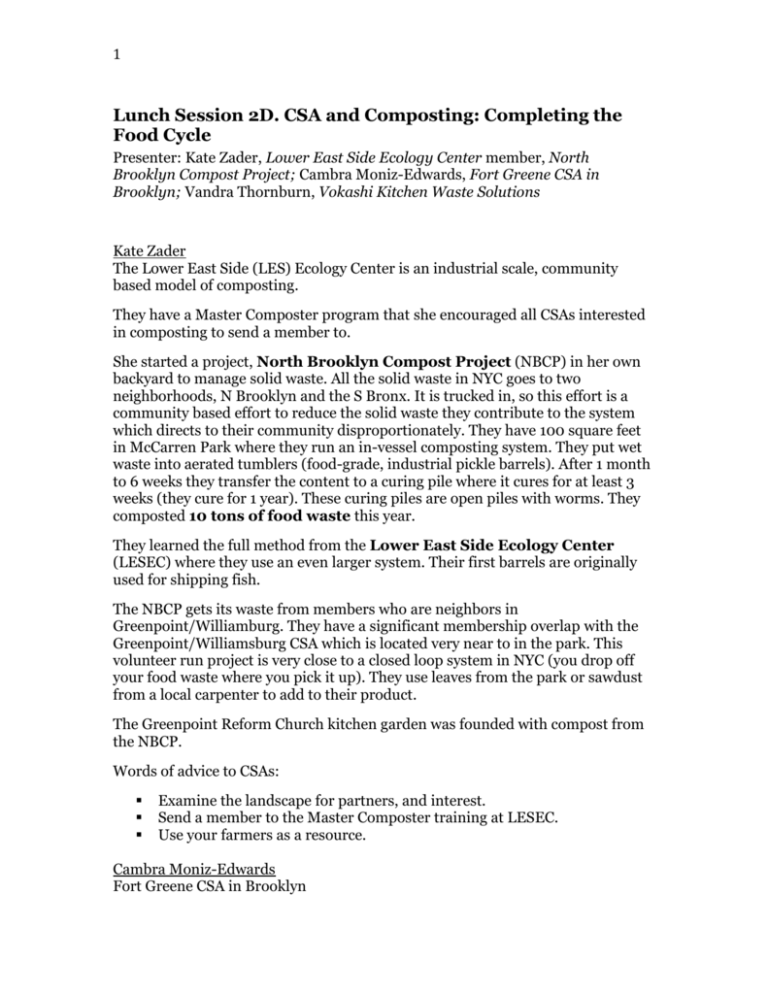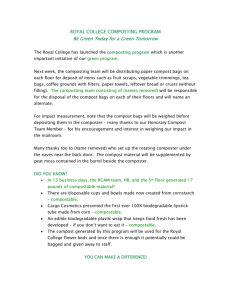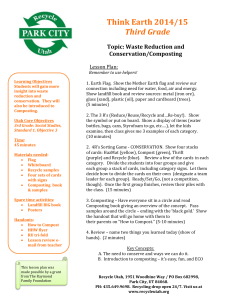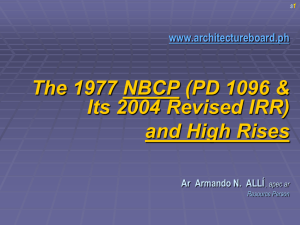Lunch Session 2D. CSA and Composting
advertisement

1 Lunch Session 2D. CSA and Composting: Completing the Food Cycle Presenter: Kate Zader, Lower East Side Ecology Center member, North Brooklyn Compost Project; Cambra Moniz-Edwards, Fort Greene CSA in Brooklyn; Vandra Thornburn, Vokashi Kitchen Waste Solutions Kate Zader The Lower East Side (LES) Ecology Center is an industrial scale, community based model of composting. They have a Master Composter program that she encouraged all CSAs interested in composting to send a member to. She started a project, North Brooklyn Compost Project (NBCP) in her own backyard to manage solid waste. All the solid waste in NYC goes to two neighborhoods, N Brooklyn and the S Bronx. It is trucked in, so this effort is a community based effort to reduce the solid waste they contribute to the system which directs to their community disproportionately. They have 100 square feet in McCarren Park where they run an in-vessel composting system. They put wet waste into aerated tumblers (food-grade, industrial pickle barrels). After 1 month to 6 weeks they transfer the content to a curing pile where it cures for at least 3 weeks (they cure for 1 year). These curing piles are open piles with worms. They composted 10 tons of food waste this year. They learned the full method from the Lower East Side Ecology Center (LESEC) where they use an even larger system. Their first barrels are originally used for shipping fish. The NBCP gets its waste from members who are neighbors in Greenpoint/Williamburg. They have a significant membership overlap with the Greenpoint/Williamsburg CSA which is located very near to in the park. This volunteer run project is very close to a closed loop system in NYC (you drop off your food waste where you pick it up). They use leaves from the park or sawdust from a local carpenter to add to their product. The Greenpoint Reform Church kitchen garden was founded with compost from the NBCP. Words of advice to CSAs: Examine the landscape for partners, and interest. Send a member to the Master Composter training at LESEC. Use your farmers as a resource. Cambra Moniz-Edwards Fort Greene CSA in Brooklyn 2 She is in her third year of being part of the CSA, she is an organizing member of the core group. They have tried a few different things for composting with their CSA. The first year they tried to collaborate with a local community garden that would pick up food waste from the distribution site at the end of the day. For them, this was not a great model because they didn’t have a strong enough relationship with the community garden. If it didn’t get picked up they were left with a lot of food waste that they couldn’t do much about. They did some more research last year because they felt very strongly about composting their food waste and wanted to find a feasible way to do it. They found that interest in composting was very high in their neighborhood and actually most of the community gardens in the area were kind of overwhelmed with the amount of compost they were trying to take in already. So, last year their model was to serve as a resource for members who wanted to learn more. They had a couple of demonstrations, from Vandra (see below) and another member who was familiar with home worm bins. Vandra Thornburn Vokashi Kitchen Waste Solutions She is trying to create a service model for composting in NYC. She uses the Vokashi method, which is a Japanese method based on fermenting food waste. Basically, you collect food waste in a bin and then add bran made up of effective microoganisms (yeast, lactic acid and phototropic). These microorganisms pickle the food waste and keep it from going bad and putrifying. Once the bucket is full, you can add the product to your compost, worm bin, or they can come pick up your full bucket and replace it with an empty one. She charges $40 per pickup, but if you can get lots of neighbors involved, the price drops to $25. Questions What are the restrictions or parameters for what you can put in the Vokashi system? No liquids, fruit juices, yogurt. You can add meats, dairy, but bones are not allowed in her service (if you managed it on your own they would be fine). You said the product is not the same as compost, can you clarify? Anaerobic breakdown vs. aerobic breakdown. This is sort of like an extra step in the process. How did you get a site at McCarren Park? We took it! Find out who owns what in your area. Each site can be a custom job, so don’t overlook anything. 3 Now do you have a relationship with the park manager? There is no park manager. But we do have a working relationship with the staff, park cops and gardeners. We basically pay our rent in compost that gets used around the park or in other public green spaces. I have a technical clarification, what is the criteria for the product you take in? Our main goal is to reduce the amount of solid waste trucked through our neighborhood. If our goal was to grow great organic vegetables, we might have different criteria, but that’s not our focus. As such, we are not picky about what we take. We are providing an alternative to overpriced, dead dirt that you can get at the hardware store. How big a space do you need to compost food waste from a 150 member CSA? Do a pilot! Try it with your core group and then estimate up. That way you will also have a well developed group to lead the efforts on a larger scale.









